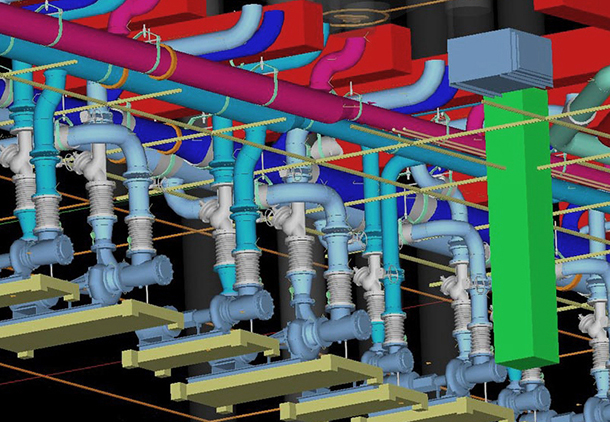Construction science intern assumes BIM responsibilities

Tanner Trimm
It’s unusual for an intern to head meetings between mechanical, electrical and plumbing subcontractors at a construction jobsite, but Tanner Trimm, a fourth-year construction science student at Texas A&M, did just that because of what he’d learned in a building information modeling class.
Trimm, interning from Aug. 2012 – Jan. 2013 with Manhattan Construction Company at a 4-story, $90 million Southwest Airlines building jobsite near Love Field in Dallas, saw an opportunity to deepen his role at the site when the project architect stopped providing computer assisted design files, which the site’s senior field engineer was using to make project updates.
“I was the only one on the team who knew how to create CAD files from a BIM model,” said Trimm, who had previously taken a BIM class led by Julian Kang, associate professor of construction science. A BIM model is a virtual, 3-D representation of a building and its systems.
“I told the project manager if they could provide the BIM program I would be more than happy to handle that responsibility,” he said.
Then, because Trimm was the only person at the jobsite familiar with BIM’s clash detection capabilities — which identify when a design inadvertently contains, for instance, water pipes and air ducts in the same place — the site’s project manager chose Trimm to lead the project’s clash detection meetings with mechanical, electrical and plumbing subcontractors.
“Because I was just an intern, I was hesitant to preside over the meetings, since the subcontractors were more experienced,” said Trimm. “But the senior project engineer helped me coordinate every meeting.”
Before his internship ended, Trimm left instructions at the site so the BIM-based clash detection efforts could continue.
“I created a few instruction documents and created all the necessary filing systems and forms to use,” he said.
Trimm was coordinating clash detection in addition to his internship’s original responsibilities, which included handling information requests from subcontractors and new worker safety training.
“Most of the requests came from subcontractors and bidding companies asking to clarify specific parts of the project drawings,” said Trimm.
He also helped the site’s safety engineer familiarize new workers with Manhattan’s safety procedures and the jobsite.
“I was introduced to a lot of aspects of the construction industry during my internship,” said Trimm. “All of it has been very beneficial to my growth as a future construction professional.”
Tags
- academics
- building a better texas
- construction science
- internships
- partnerships
- rss
- technology
- undergraduate work
Related Posts

More compaines seeking construction students at job fair

New BIM CAVE facilitates students' 3-D visualizations

Student-designed, built ‘tiny’ homes to house homeless

Texas A&M researchers enabling buildings to ‘breathe’

Student-built tiny homes destined to house homeless
Follow Us
Facebook Twitter Vimeo Youtube Flickr RSS
Recent Posts

Planning prof heads study of disaster housing aid

A message from the dean

Former student remembered as expert planner

Leading educator named new head of Architecture Dept.

 During his internship, construction science major Tanner Trimm used his knowledge of building information modeling to head meetings between jobsite subcontractors.
During his internship, construction science major Tanner Trimm used his knowledge of building information modeling to head meetings between jobsite subcontractors.



_thumbnail_small.png)
